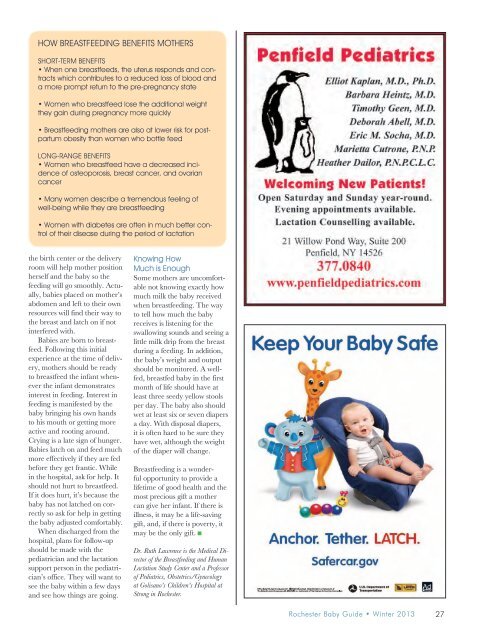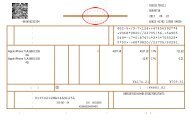baby magazine-1
Create successful ePaper yourself
Turn your PDF publications into a flip-book with our unique Google optimized e-Paper software.
How Breastfeeding Benefits Mothers<br />
Short-term Benefits<br />
• When one breastfeeds, the uterus responds and contracts<br />
which contributes to a reduced loss of blood and<br />
a more prompt return to the pre-pregnancy state<br />
• Women who breastfeed lose the additional weight<br />
they gain during pregnancy more quickly<br />
• Breastfeeding mothers are also at lower risk for postpartum<br />
obesity than women who bottle feed<br />
Long-range Benefits<br />
• Women who breastfeed have a decreased incidence<br />
of osteoporosis, breast cancer, and ovarian<br />
cancer<br />
• Many women describe a tremendous feeling of<br />
well-being while they are breastfeeding<br />
• Women with diabetes are often in much better control<br />
of their disease during the period of lactation<br />
the birth center or the delivery<br />
room will help mother position<br />
herself and the <strong>baby</strong> so the<br />
feeding will go smoothly. Actually,<br />
babies placed on mother’s<br />
abdomen and left to their own<br />
resources will find their way to<br />
the breast and latch on if not<br />
interfered with.<br />
Babies are born to breastfeed.<br />
Following this initial<br />
experience at the time of delivery,<br />
mothers should be ready<br />
to breastfeed the infant whenever<br />
the infant demonstrates<br />
interest in feeding. Interest in<br />
feeding is manifested by the<br />
<strong>baby</strong> bringing his own hands<br />
to his mouth or getting more<br />
active and rooting around.<br />
Crying is a late sign of hunger.<br />
Babies latch on and feed much<br />
more effectively if they are fed<br />
before they get frantic. While<br />
in the hospital, ask for help. It<br />
should not hurt to breastfeed.<br />
If it does hurt, it’s because the<br />
<strong>baby</strong> has not latched on correctly<br />
so ask for help in getting<br />
the <strong>baby</strong> adjusted comfortably.<br />
When discharged from the<br />
hospital, plans for follow-up<br />
should be made with the<br />
pediatrician and the lactation<br />
support person in the pediatrician’s<br />
office. They will want to<br />
see the <strong>baby</strong> within a few days<br />
and see how things are going.<br />
Knowing How<br />
Much is Enough<br />
Some mothers are uncomfortable<br />
not knowing exactly how<br />
much milk the <strong>baby</strong> received<br />
when breastfeeding. The way<br />
to tell how much the <strong>baby</strong><br />
receives is listening for the<br />
swallowing sounds and seeing a<br />
little milk drip from the breast<br />
during a feeding. In addition,<br />
the <strong>baby</strong>’s weight and output<br />
should be monitored. A wellfed,<br />
breastfed <strong>baby</strong> in the first<br />
month of life should have at<br />
least three seedy yellow stools<br />
per day. The <strong>baby</strong> also should<br />
wet at least six or seven diapers<br />
a day. With disposal diapers,<br />
it is often hard to be sure they<br />
have wet, although the weight<br />
of the diaper will change.<br />
Breastfeeding is a wonderful<br />
opportunity to provide a<br />
lifetime of good health and the<br />
most precious gift a mother<br />
can give her infant. If there is<br />
illness, it may be a life-saving<br />
gift, and, if there is poverty, it<br />
may be the only gift. <br />
Dr. Ruth Lawrence is the Medical Director<br />
of the Breastfeeding and Human<br />
Lactation Study Center and a Professor<br />
of Pediatrics, Obstetrics/Gynecology<br />
at Golisano’s Children’s Hospital at<br />
Strong in Rochester.<br />
Rochester Baby Guide • Winter 2013 27







